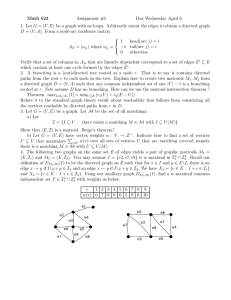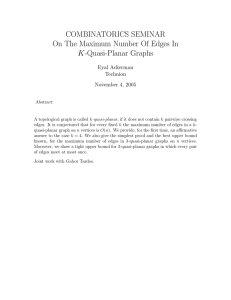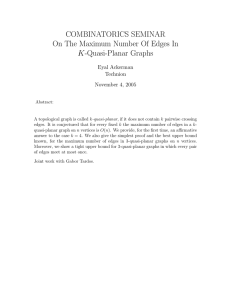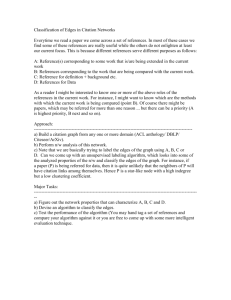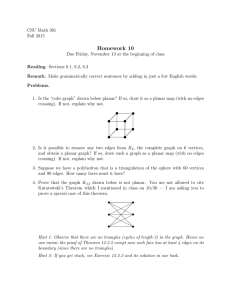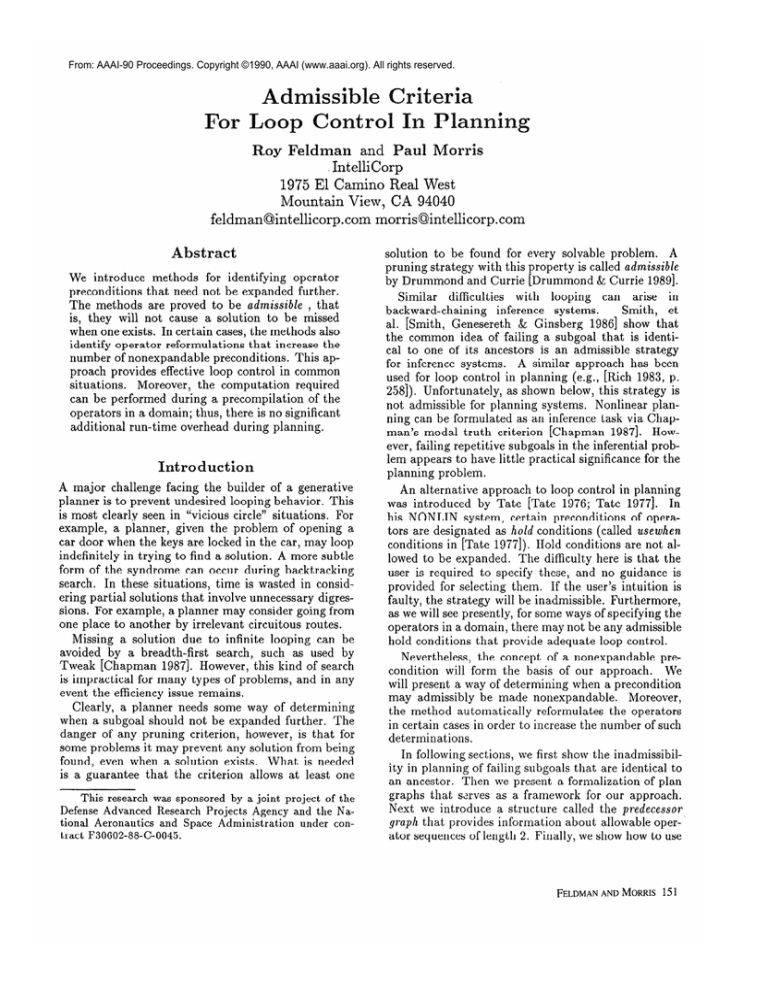
From: AAAI-90 Proceedings. Copyright ©1990, AAAI (www.aaai.org). All rights reserved.
Admissible
Roy Feldman
Criteria
Paul
and
Morris
IntelliCorp
1975 El Camino
Mountain
View,
feldman@intellicorp.com
Abstract
We introduce
methods
for identifying
operator
preconditions
that need not be expanded further.
The methods
are proved to be admissible , that
is, they will not cause a solution to be missed
when one exists. In certain cases, the methods also
identify operator reformulations
that increase the
number of nonexpandable
preconditions.
This approach provides effective loop control in common
Moreover,
the computation
required
situations.
can be performed during a precompilation
of the
operators in a domain; thus, there is no significant
additional run-time overhead during planning.
Introduction
A major
challenge facing the builder of a generative
planner is to prevent undesired looping behavior.
This
is most clearly seen in “vicious circle” situations.
For
example,
a planner, given the problem of opening a
car door when the keys are locked in the car, may loop
indefinitely in trying to find a solution. A more subtle
form of the syndrome
can occur during backtracking
search.
In these situations,
time is wasted in considering partial solutions that involve unnecessary
digressions For example, a planner may consider going from
one place to another by irrelevant circuitous routes.
Missing a solution
due to infinite looping can be
avoided by a breadth-first
search,
such as used by
Tweak [Chapman
19871. However, this kind of search
is impractical
for many types of problems, and in any
event the efficiency issue remains.
Clearly, a planner needs some way of determining
when a subgoal should not be expanded further.
The
danger of any pruning criterion,
however, is that for
some problems it may prevent any solution from being
found, even when a solution exists.
What is needed
is a guarantee
that the criterion
allows at least one
This research
was sponsored
by a joint project of the
Defense Advanced
Research
Projects
Agency and the National Aeronautics
and Space Administration
under contract l?30602-88-C-0045.
Real
West
CA
94040
morris@intellicorp.com
solution to be found for every solvable problem.
A
pruning strategy with this property is called admissible
by Drummond and Currie [Drummond & Currie 19891.
Similar
difficulties
with
looping
can
arise
in
Smith,
et
backward-chaining
inference
systems.
al. [Smith,
Genesereth
& Ginsberg
1986] show that
the common idea of failing a subgoal that is identical to one of its ancestors
is an admissible
strategy
A similar approach has been
for inference systems.
used for loop control in planning (e.g., [Rich 1983, p.
2581). Unfortunately,
as shown below, this strategy is
not admissible for planning systems.
Nonlinear planning can be formulated as an inference task via Chapman’s modal truth criterion
[Chapman
19871. However, failing repetitive subgoals in the inferential problem appears to have little practical significance for the
planning problem.
An alternative
approach to loop control in planning
was introduced
by Tate [Tate 1976; Tate 19771. In
his NONLIN system, certain preconditions
of operators are designated as hold conditions (called usewhen
conditions in [Tate 19771). Hold conditions are not allowed to be expanded.
The difficulty here is that the
user is required to specify these, and no guidance is
provided for selecting them. If the user’s intuition is
faulty, the strategy will be inadmissible.
Furthermore,
as we will see presently, for some ways of specifying the
operators in a domain, there may not be any admissible
hold conditions that provide adequate loop control.
Nevertheless,
the concept of a nonexpandable
precondition
will form the basis of our approach.
We
will present a way of determining
when a precondition
may admissibly
be made nonexpandable.
Moreover,
the method automatically
reformulates
the operators
in certain cases in order to increase the number of such
determinations.
In following sections, we first show the inadmissibility in planning of failing subgoals that are identical to
an ancestor.
Then we present a formalization
of plan
graphs that serves as a framework for our approach.
Next we introduce
a structure
called the predecessor
graph that provides information
about allowable operator sequences of length 2. Finally, we show how to use
FELDMANAND MORRIS 15 1
this graph to identify admissibly nonexpandable preconditions. The proofs are contained in the appendix.
Robot
Recharging
Problem
In this section, we present an example that resists existing methods of loop control. In particular, it shows
the inadmissibility of failing a goal that is identical to
an ancestor. The operator representation we will give
for the problem, although a natural one, is also not
amenable to control with hold conditions. We will see
later that successful loop control requires a reformulation of one of the operators.
The example, called the “robot recharging problem,”
was first described in [Morris 19841. A robot is capable
of holding a unit of charge. As long as it is charged, the
robot may move around. We assume that moving uses
a negligible amount of energy. The robot also needs
to fix a hole in its body. We assume this uses up all
its energy, so that the robot becomes discharged. The
robot is initially at location A. There is a power source
at location B where the robot can recharge. The goals
of the robot are to fix the hole and be charged.
The following is the STRIPS representation of the
domain.
FIX
Preconditions
and delete conditions:
CHARGED,HOLE
Add conditions: UNCHARGED,
NO-HOLE
RECHARGE
Preconditions: AT(B), UNCHARGED
Delete condition: UNCHARGED
Add condition: CHARGED
GO
Preconditions: CHARGED, AT(?X)
Delete condition: AT(?X)
Add condition: AT (?Y)
Initial state: AT(A), CHARGED,
Goals: CHARGED,NO-HOLE
HOLE
Obviously, the robot must first go to location B.
Only then can it perform its task and still be able
to recharge. However, if we examine the structure of
this plan, we see that AT(B) is a subgoal of CHARGED.
When AT(B) is expanded by a Go action, this introduces a further subgoal of CHARGED, which is identical
to the ancestor goal. Note that if we fail this subgoal,
the problem will not be solved. (It may be helpful to
refer to figure 1 below.)
If we use no loop control method, the problem can be
solved. Consider, however, the closely related problem
where the robot is uncharged in the initial state. This
has no solution. Without some loop control criterion,
a planner faced with this problem will loop endlessly.
The challenge is to find some method that cuts off the
search in the second situation, but not in the first.
152 AUTOMATEDREASONING
The most obvious candidates for hold conditions
are the UNCHARGED
precondition in RECHARGE, the
AT(?X) in GO, and the HOLE in FIX. Unfortunately,
these are not sufficient to terminate looping in the second situation, since there is a cycle through the AT(B)
precondition of RECHARGE
and the CHARGED precondition of GO. Intuitively, it seems as if the AT(B) in
RECHARGE
might be a hold condition. However, we
saw above that constructing the plan in the first situation requires AT(B) to be expanded.
Notice that the need for the GO action indirectly results from the presence of the NO-HOLE goal, but this
is not reflected in the goal ancestor path. Interestingly, the methods we will consider have the effect of
reformulating the operators in a way that diverts the
ancestor path to this goal.
Plan
Graphs
We use the general framework of nonlinear planning introduced by Sacerdoti [Sacerdoti 19771 and Tate [Tate
19771. Planning proceeds in stages. At each stage, a
goal is selected to work on. The planner satisfies the
goal either by matching it to an already achieved fact,
or by introducing a new action into the plan. In the
former case, we say the goal is linked to the matching
fact. In the latter case, we say the goal is expanded.
The possible actions are determined by a set of
STRIPS operators [Nilsson 19801. However, we require
that the operators be formulated so that they are never
applied in situations where one of their delete conditions is already false, or where one of their add conditions is already true; i.e., none of the adds or deletes
are no-ops. This is not a severe restriction. First, operators that are constructed in practice generally have
this property. Second, an operator that does not can
always be replaced by several more specialized operators that do satisfy the restriction. We also require
that the operators be formulated to avoid the need for
coincident solutions, that is, where two preconditions,
or two add conditions, of the same operator become
instantiated in such a way that they coincide. Again,
this can be accomplished by using more specialized operators, if necessary.
We associate each action with two sets of facts: the
before-facts, consisting of the delete conditions and undeleted preconditions; and the after-facts, comprised of
the add conditions and undeleted preconditions. This
division may be viewed as a relational production [Vere
19771 representation of the action.
A plan graph is a graphical representation of a plan
that shows how the after-facts of various actions contribute to the before-facts of other actions. Formally,
a plan graph is a directed acyclic multigraph where
the nodes are labeled with actions, and the edges are
labeled with facts. The labeling on an edge connecting two actions must belong to the after-facts of the
first action and the before-facts of the second. There
is also a distinguished START action whose after-facts
Figure
1: Plan Graph
For Robot
Problem
supply the initial facts for the plan, and a STOP action
whose before-facts
include the atomic top-level goals.
Figure 1 shows the plan graph for a solution t; the
robot problem.
For linguistic convenience,
we blur the distinction
between a node and the action it is labeled with. For
example, we may speak of the “before-facts”
of a node,
and the “incoming edges” of an action.
The following concepts will be useful in the subsequent discussion.
Note that every directed acyclic multigraph
determines a partial order on its nodes and edges. Given
a plan graph, we say a node or edge precedes another
node or edge if it precedes it in this partial order. Furt hermore, we say a node or edge is parallel to a second
node or edge if neither precedes the other.
A plan graph is complete if the before-facts
of each
action in the plan are supplied by after-facts of other
actions, i.e., if the incoming - edges
to each action cover
all of the before-facts.
This corresponds to a situation
where there are no remaining unsolved goals. Unless
otherwise stated, in the remainder of this paper we will
assume plan graphs are complete.
Also, unless otherwise clear from the context, we restrict our attention
to plan graphs that are conflict-free in the following
sense: no edge is parallel to an action that deletes the
fact that the edge is labeled with. This is closely related to the usual concept of plan conflict (e.g., [Tate
19761).
It is never necessary for two incoming edges to an
action to be labeled with the same fact, since we can
simply drop one of the edges without affecting the completeness of the plan. Expressed in terms of planning,
a goal is satisfied by linking to a single matching fact.
However, traditional
approaches to planning allow a
fact to satisfy more than one goal. Thus, it is possible
for two outgoing edges from an action to be labeled
with the same fact. We will call this a collision. The
following result indicates that collisions are not essential, and-could be excluded without seriously impairing
a planner.
Theorem
1 For every conflict-free plan graph, there
is a collision-free plan graph with the same actions that
solves the same problem.
In light of theorem 1, we assume from now on that
the plan graphs are collision-free.
This restriction turns
out to be very useful for proving results about plan
graphs.
Note that the theorem shows it is admissible
to
adopt an approach to planning where a fact that is
linked to a goal is “used up” by the goal, i.e., becomes
unavailable for linking by another goal. In the case
where the consuming goal corresponds to a precondition of an action that remains true after the action,
the fact is “put back” as a postcondition
of the action.
This approach to planning has been studied in [Morris
19841.
We now introduce a notion that is related to the
concept of primary cut introduced by Drummond and
Currie [Drummond & Currie 19891. We will say a set
of edges is parallel if every edge in the set is parallel
to every other edge in the set. A cut of a plan graph
is a maximal parallel set of edges, i.e., a parallel set of
edges that is not a subset of any other parallel set of
edges.
The following theorem (actually, its corollary) is central to reasoning about plan graphs.
Theorem
2 For every cut, there is a reachable state
of the domain that contains each fact in the labeling of
the cut. Moreover,
no two edges in the cut are labeled
with the same fact.
Corollary
same label
parallel to
flicts with
2.1 Edges that are parallel cannot have the
or contradictory
labels. A node cannot be
an edge whose label coincides with or conone of its before-facts or after-facts.
To apply the corollary, we need to reason about
inconsistencies.
In principle, any domain constraints
could be used for this purpose.
However, we have
found the most useful constraints to be exclusive-or relationships.
Inconsistencies
based on such constraints
can be efficiently determined.
In [Morris & Feldman
19891, a method is presented for automatically
extracting candidate exclusive-or relationships from operator
descriptions.
The Predecessor
Graph
Obviously, not every combination of actions is possible
or useful. We now address the question of what actions
can appear next to each other in a plan graph.
Given a plan graph, we will say a node A is an immediate predecessor of a node B if A precedes B, and
there is no other node C such that A precedes C and C
precedes B. We are interested in necessary conditions
for a node to be an immediate predecessor.
It is easy to see that if A is an immediate predecessor
of B, then some outgoing edge of A must be an incoming edge of B. (The converse is not necessarily true:
A could be connected by an edge to B without being
an immediate predecessor, since there may be a second
route from A to B.) Corollary 2.1 provides additional
requirements.
Note that the after-facts of A must be
FELDMANANDMORRIS
153
to B.
c
RCHRG
Figure 2: Predecessor
The above uses consistency analysis to rule out potential operator combinations
in forming the predecessor graph. Other applications of consistency analysis in
planning appear in the work of Irani and Chen
[Irani
& Cheng 19871, and Drummond
and Currie f Drummond & Currie 19891.
FIX
Graph
For Robot
Problem
consistent with the before-facts
of B; otherwise, we
would have parallel contradictory
edges.
This requirement
allows us to completely
rule out
certain combinations
of operators. For example in the
robot recharging problem,
no instance of GO can be
an immediate
predecessor of RECHARGE
because the
CHARGED
precondition
of the former conflicts with
the UNCHARGED
precondition
of the latter.
Similarly, FIX cannot immediately precede GO or itself, and
RECHARGE
cannot immediately
precede itself.
Certain other combinations,
although not impossible, can be ruled out as not being sensible. Suppose,
for example, an action A is immediately preceded by its
exact inverse B. Since the actions are inverses, there
is an exact match between the after-facts of B and the
before-facts of A. Corollary 2.1 then implies that every outgoing edge of A must be an incoming edge of B
and vice versa; otherwise we would have parallel edges
with the same label.
It follows that the plan graph
could be simplified by excising the portion from A to
B and directly joining the resulting dangling edges.
There are no inverses in the robot problem.
However, a further example of a non-sensible situation occurs when a two operator combination
is subsumed
by a single operator.
Suppose in the robot problem
that GO is immediately
preceded by itself. The binding of ?Y in the earlier instance of GO must match the
binding of ?X in the other; otherwise the consistency
requirement is violated.
But then the after-facts of
the earlier instance coincide with the before-facts
of
the other, and all the edges from the former must connect to the latter. It follows that the portion of the
plan graph containing the two GOs can be replaced by
a single GO. Thus, we can assume that GO does not
immediately
precede itself.
After using the techniques above to eliminate various combinations,
we are left with a set of combinations that have not been ruled out. We can form a
graph of the operators that reflects these. We call this
the predecessor
graph. Figure 2 shows the predecessor
graph for the robot problem.
The predecessor graph can often be annotated with
constraints on bindings that arise from the immediate
predecessor relationship.
For example, if G 0 is immediately preceded by RECHARGE,
then uniqueness of
location requires that the variable ?x in GO be bound
154 AUTOMATEDREASONING
Loop
Control
We now consider how to use the predecessor graph to
determine nonexpandable
preconditions.
The method
is based on results in this section.
We define a plan graph to be minimal if it contains no unnecessary actions, i.e., there is no other plan
graph that solves the same problem with a proper subset of the actions. To prove admissibility
of a pruning
criterion, it is enough to show that every minimal plan
graph can be constructed within the bounds of the criterion.
The following concept will also be useful. We say an
operator A is guarded by one of its preconditions
G if,
for every minimal plan graph in which A occurs, the
before-fact of A corresponding
to G is an after-fact or
a before-fact
of every immediate predecessor of A.
Our first theorem on loop control involves a special
case of A being guarded by G.
Theorem
dition G
graph in
sponding
decessor
3 It is admissible not to expand a preconof an operator A if for every minimal plan
which A occurs, the before-fact of A correto G is a before-fact of every immediate preof A.
Intuitively, theorem 3 is used to make a operator
precondition
nonexpandable
by way of deferral. If a
precondition
G meets the conditions of the theorem, it
means that the expansion of any of the sibling preconditions of G are guaranteed to introduce a precondition
identical to G. Thus, G can be expanded later. Our
next result presents an alternative means of determining nonexpandability.
Theorem
4 It is admissible not to expand a deleted
precondition
G of an operator A if A is guarded by G
and, for every minimal plan graph in which A appears,
the facts added by A are contained in the before-facts
of every immediate predecessor
of A.
Moreover,
this criterion
and that of theorem 3 are
simultaneously
admissible.
The proof of theorem 4 is based on showing the expansion of the precondition
is unnecessary because either some other goal can be expanded to introduce the
same action, or any possible expansion will produce a
non-minimal
plan graph.
The following examples show how these theorems
may be used. Our first example is a formalization
of
the car keys problem. We have the following operator
descriptions.
OPEN-CAR-DOOR
Preconditions:
Delete
condition:
Add condition:
DOOR-CLOSED,
HAVE-KEYS
DOOR-CLOSED
DOOR-OPEN
GET-KEYS-FROM-CAR
Preconditions:
Delete
condition:
Add condition:
KEYS-IN-CAR, DOOR-OPEN
KEYS-IN-CAR
HAVE-KEYS
In this example, consistency analysis shows that neither operator
can have any immediate
predecessor,
i.e., all operator sequences of length 2 are impossible.
Thus, every precondition
can admissibly be made nonexpandable.
This gives us the loop control we need.
Our next example is the robot problem.
Consider
the AT(?X) precondition
of GO. The only immediate
predecessor
of GO is RECHARGE, which has AT(B) as
a precondition.
We noted earlier that when GO is immediately preceded by RECHARGE
the ?X in GO must
be bound to B. Thus, the precondition
is also a precondition of every possible immediate predecessor.
We
conclude by theorem 3 that AT(?X) is admissibly nonexpandable for this domain.
Also,
consider
the UNCHARGED
precondition
of
RECHARGE.
The only immediate
predecessor
is FIX.
Thus, UNCHARGED
guards RECHARGED.
Note that
the only fact added by RECHARGE
is CHARGED.
This
is among the preconditions
of FIX. Moreover,
UNCHARGED is deleted by RECHARGE.
Thus, by theorem
4, it is a nonexpandable
precondition.
We would like to make the AT(B) precondition
of
RECHARGE
nonexpandable.
However, as things stand
the method does not apply, since the immediate predecessor, FIX, does not have AT(?X) as a precondition.
Indeed, we noted earlier that with this operator representation,
AT(B) needs to be expanded to solve the
robot problem.
Observe, however, that if we include AT(?X) as an
additional precondition
in the FIX operator,
then the
criterion of the theorem is satisfied,
and AT(B) can
be made a nonexpandable
precondition
of RECHARGE.
Moreover, it is admissible to augment the FIX operator
in this way, since every state must satisfy some instance
of AT(?x). The reason why the robot problem is now
solvable is that the AT(?X) precondition
of FIX can be
expanded instead.
Note that we have shifted the goal
ancestor path for the expansion of AT(?X) so that it
now leads to the NO-HOLE
top-level goal. Intuitively,
the problem with the original representation
was that
the expansions were not correctly motivated.
Figure 3
shows the reformulated
plan graph for this problem.
This technique
of modifying
the operators
can be
made systematic.
In general, we may need to replace
the immediate predecessor operator with several operators that are augmented with the different members
of some exclusive-or set that includes the precondition
under consideration.
(If no better exclusive-or
set is
Figure
3: Reformulated
Plan
Graph
available, the fact and its negation can be used.) Note
that consistency
requirements
ensure that of the replacement operators, only the one corresponding
to the
precondition
is an immediate predecessor.
It is easy to see that the modification
procedure can
be applied to make any precondition
nonexpandable
provided that no immediate
predecessor
has the precondition as an add condition.
Observe that all the preconditions
of RECHARGE
are
now nonexpandable.
It can be verified that every potential loop in the robot problem passes through the
RECHARGE
operator.
Thus, no loops remain.
It is important to note that the methods provide only
sufficient conditions
for admissible
nonexpandability,
and it is not true in general that they will prevent all
loops. We can think of theorem 3 as eliminating
goal
repetitions
where a goal is an immediate subgoal of itself. Theorem 4 applies to goals that repeat after two
steps. Slightly larger repetition
intervals can be handied by combining
operators
as necessary
to reduce
the repetition
distance.
However, in the blocks world,
for example, there can be repetitions
with an indefinite number of intervening goals, and neither theorem
applies in this case. Nevertheless,
the results here appear to cover many of the intuitive examples of hold
conditions.
Closing
Remarks
One of the features which distinguishes
modern work
in AI from that of earlier periods is an increasing contern for rigorous analysis and deeper understanding
of
the techniques studied. Previous loop control methods
in planning may be classified as engineering
art. Indeed, loop control is an important,
but neglected issue
in generative
planning.
We have presented provably
correct methods that are effective in common situations. An important
observation
that follows from the
results in this paper is that operator descriptions may
need to be reformulated
in order to facilitate control.
The methods of the paper can be used to identify useful
reformulations.
A system that identifies nonexpandable
preconditions based on the theorems
in the paper has been
successfully
implemented.
Our present implementation uses a full theorem prover (the Boyer-Moore
the-
FELDMANANDMORRIS
155
orem prover [Boyer & Moore 19791) to reason about
inconsistency,
which limits its applicability.
However,
in practice, less costly reasoning about exclusive-or relationships should be sufficient. Note also that the reasoning is performed during a precompilation
of the operators in a domain, so the cost is amortized over all
problem-solving
in that domain.
Nonexpandability
is only part of the content of the
hold condition idea of Tate; the other part is a determination that linking need not be delayed until side
effects of other operators are available. This property
is called eflective isolation in [Morris 19841. The predecessor graph may also be useful for determinations
of
effective isolation, and current work is exploring this.
Acknowledgment
gestions to improve
We thank Bob
the presentation.
Appendix:
Filman
for sug-
Proofs
Theorem
1: For every conflict-free plan graph, there
is a collision-free plan graph with the same actions that
solves the same problem.
Proof:
Suppose an action has two outgoing edges
labeled with the same fact F. If the two edges are received by a single action, then one edge is redundant
and can be removed.
Otherwise, the edges must be
received by different actions.
At least one of these,
say A, is not preceded by the other, B. If the plan is
conflict-free, then the receiving action A cannot delete
the fact F, since it is parallel to the edge that goes
to B. Thus, F must also occur as an after-fact of A.
Now the original F-labeled edge to B can be replaced
by an edge from A to B. If there is already an outgoing edge from A labeled with F, then the above process
can be repeated. Note that each repetition moves the
collision closer to the STOP node. Ultimately, either it
disappears, or a redundancy occurs among the incoming edges to the STOP node and can be removed.
Theorem
2: For every cut, there is a reachable
state of the domain that contains each fact in the labeling of the cut. Moreover, no two edges in the cut
are labeled with the same fact.
Proof: We say a node precedes a cut if it precedes
some edge in the cut. The theorem will be proved by
induction on the number of nodes that precede a cut.
Note that the outgoing edges from the START node
constitute a cut that is preceded only by the START
node itself. We call this the initial cut. Clearly, the
result holds for the initial cut.
Now consider some other cut. Let A be a node preceding the cut that is maximally close to the cut, i.e.,
A does not precede any other node that precedes the
cut. Let e be any outgoing edge of A. We show e must
belong to the cut. Suppose otherwise. Then e cannot
precede any edge in the cut; otherwise there would be
another node between A and the cut. Also, e cannot
be preceded by any edge in the cut. If it did, then A
could not precede the cut. Thus, e is parallel to every
156 AUTOMATEDREASONING
edge in the cut. But this contradicts the definition of
a cut, which requires it to be a maximal parallel set of
edges.
We have shown that every outgoing edge of A belongs to the cut. Let us call this cut C. Now consider
the set of edges obtained from C by replacing the outgoing edges of A with its incoming edges. It is not hard
to verify that this is also a cut, which we will call C’.
By the inductive hypothesis, the labels of edges in C’
are free of duplicates, and are contained in some reachable state. The preconditions
of A are satisfied in that
state. Thus, the state resulting from applying A is also
reachable. This state contains the facts corresponding
to edges in C. This proves the first part of the result.
Note that the only way that applying A could produce a duplicate edge (we are assuming no collisions
among the outgoing edges of A) would be if one of its
outgoing edges had the same label as an edge common
to the two cuts. But then A would be applicable in
a situation where one of its add conditions is already
true, contrary to our restriction on operators.
This
shows the second part of the result.
Corollary 2.1: Edges that are parallel cannot have
the same label or contradictory
labels. A node cannot
be parallel to an edge whose label coincides with or
conflicts with one of its before-facts or after-facts.
ProofiIf
two edges are parallel, then there is some
cut that contains them both. By the theorem, the cut
has no duplicate labels.
Furthermore,
the labels are
contained in some reachable state, so they cannot be
contradictory.
Now suppose a node A is parallel to an edge e. It is
easy to see that the incoming and outgoing edges of A
must also be parallel to e. Thus, the only case we need
to consider is that of an unused after-fact.
Note that
the plan graph can be modified to include the afterfact as a top level goal without changing any of the
labels. Then, the previous reasoning can be applied to
the after-fact. The result follows.
Lemma 1 Suppose A is guarded by a precondition
G.
Consider some minimal plan graph in which A occurs.
Let e be the incoming edge to A that corresponds to G,
and let B be the node of which e is an outgoing edge.
Then B is an immediate
predecessor
of A, and is the
only immediate predecessor
of A in the plan graph.
Proof:
Clearly, B is a predecessor of A. Suppose
there is some other node C that is an immediate predecessor of A. Then C has either an afler-fact or a beforefact that matches the label of e. Clearly, e is parallel to
C, leading to a violation of corollary 2.1. Thus, there
cannot be any other immediate predecessor. It follows
that B must be the immediate predecessor of A.
Theorem
3: It is admissible not to expand a precondition
G of an operator A if, for every minimal
plan graph in which A occurs, the before-fact of A corresponding to G is a before-fact
of every immediate
predecessor of A.
Proof:
Consider a minimal plan graph in which A
There must be some incoming edge e of A
occurs.
that corresponds to G. Suppose the edge e comes from
another node B. By the statement of the theorem, A
is guarded by G. Hence, by lemma 1, B must be an
immediate predecessor of A.
By hypothesis,
B has a before-fact
that coincides
with the label of e, and so e does not correspond to an
add condition of B. It follows that during planning,
B could not have been introduced into the plan as an
expansion of G, i.e., it must have resulted from the
expansion of some other goal (or be the START node).
Thus, it is safe to make G nonexpandable.
Theorem 4: It is admissible not to expand a deleted
precondition
G of an operator A if A is guarded by G
and, for every minimal plan graph in which A appears,
the facts added by A are contained in the before-facts
of every immediate predecessor of A.
Moreover, this criterion and that of theorem 3 are
simultaneously
admissible.
Proof:
In the following, We use the term add-fact
to describe an after-fact that corresponds
to an add
condition.
Similarly, delete-fact is a before-fact
that
corresponds to a delete condition.
Consider any minimal plan graph in which a node B
occurs. Let I be the set of outgoing edges of B that
correspond to add-facts of B, and let A be the set of
nodes that receive the edges in 1.
Each edge e in C corresponds
to a precondition
G
of some node A in A.
We claim that at least one
such G is not made nonexpandable
by the criterion of
the theorem.
Assume otherwise.
We will show that
this leads to a contradiction.
We note here that the
assumption implies that every edge from an add-fact
of B leads to a delete-fact of the connected node.
We proceed by showing all the outgoing edges of the
nodes in the set A U {B} (other than internal edges)
can be replaced by equivalent incoming edges. This
will allow all the nodes in the set to be excised, contradicting the minimality of the plan graph.
By lemma 1, B is an immediate predecessor of each
node in d. It follows that the edges being considered
for replacement are all parallel to each other. By corollary 2.1, their labels are all different. Thus, there is no
danger of two outgoing edges competing for a replacement among the incoming edges, so it is sufficient to
show that the edges can be replaced individually.
There are three cases to be considered:
outgoing
edges of (nodes in) A that correspond
to add-facts;
other outgoing edges of d; and outgoing edges of B
that do not go to d.
If e corresponds to an add-fact of some A in A, then
by the condition of the theorem, it can be replaced by
an equivalent incoming edge e’ to B.
If e is an outgoing edge of some A, but does not
correspond to an add-fact, then there must be an incoming edge e’ of A that has the same label. If e’ is
not an internal edge, then e can simply be replaced by
e’. Otherwise, e’ is an outgoing edge of B. Since its
label is not a delete-fact of A, it is not an add-fact of
B (by the assumption;
see above).
Thus, there must
be an incoming edge e” of B with the same label as e’.
In this case e can be replaced by e”.
If e is an outgoing edge of B that does not go to
some A, then it is not in E. It follows that it is not an
add-fact of B. Thus, there is some incoming edge e’ of
B with the same label, and we can replace e with e’.
This proves our claim. Thus, at least one edge in
& must correspond to a precondition
G that does not
satisfy the criterion of the theorem.
When the plan
has been constructed up to the after-facts of B, this G
can be expanded to introduce B into the plan.
Note that the G exhibited here corresponds
to an
add-fact of B; thus, B does not have an equivalent
before-fact.
It follows that G is not made nonexpandable by the criterion of theorem 3.
References
Boyer, R. S., and Moore,
Academic Press, 1979.
J.S. A Computational
Logic.
Chapman, D. Planning for conjunctive goals.
cial Intelligence,
321333-378,
July 1987.
Artifi-
Drummond,
D., and Currie, K. Goal ordering in partially ordered plans. In Proc. IJCAI-89,
pages 960965, Detroit, Michigan, 1989.
Irani, Keki B., and Cheng J. Subgoal ordering and
goal augmentation
for heuristic problem solving. In
Proc. IJCAI-87,
pages 1018-1024,
Milan, Italy, 1987.
Morris P., and Feldman, R. Automatically
derived
heuristics for planning search. In Second Irish Conference
on Artificial Intelligence
and Cognitive Science, Dublin, Ireland, 1989. Proceedings to appear in
Springer-Verlag
Brit. Comp. Sot. Workshop Series.
Morris, P. H. A Resource
Oriented Formalism
for
Plan Generation.
PhD thesis, University of California, Irvine, 1984.
Nilsson, N. J. Principles
of Artificial Intelligence.
Tioga Publishing Company, Palo Alto, Ca., 1980.
Rich, E. Artificial
McGraw-Hill,
Intelligence
1983.
Sacerdoti, E. D. A Structure for Plans and Behavior.
Elsevier North-Holland,
1977.
Smith, D. E.; Genesereth, M. R.; and Ginsberg, M.L.
Controlling recursive inference. Artifkial Intelligence,
30(3):343-389,
1986.
Tate, A. Project Planning
Using A Hierarchic
NonLinear Planner.
Research Report 25, Dept. of Artificial Intelligence, Univ. of Edinburgh, Aug. 1976.
Tate, A.
IJCAI-77,
Generating
project networks.
In Proc.
pages 888-893, Cambridge, Ma., 1977.
Vere S.A. Relational
Intelligence,
8~47-68,
production
1977.
systems.
FELDMAN
ArtificiaE
ANDMORRIS 157


